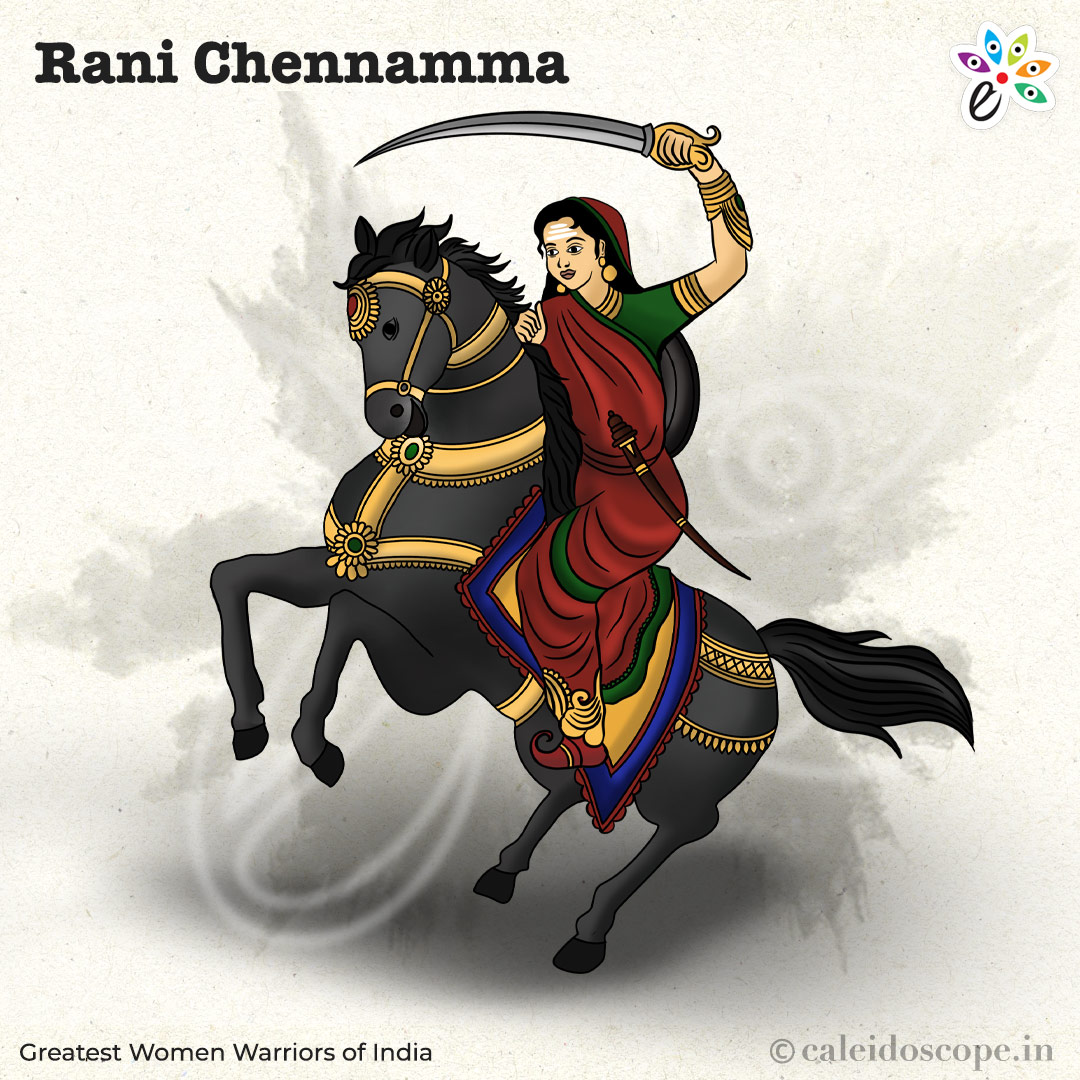
Conventionally seen as mothers, women are considered soft at heart, calm at mind, and peaceful in spirit. However, there have been times in history when women had to show their Rudra Roop to the world. Women have changed the scenario of torture and immanence by feeding their courage and transcend their strength.
Women have been a part of the warrior class for ages. Time and again, they have shown their worth and proved their capability to the world. Since ancient times, women have established themselves as formidable warriors, fighting for their people. We cannot neglect the contribution of women in making the country free and liberated.
Here is the list of the greatest women warriors of India that every Indian should know and be proud of our brave hearts.
Rani Laxmibai – Woman of Jhansi

How can we forget our Jhansi ki Rani when enlisting the women warriors of India?
She was born in 1835, Kashi, to the priest Varanasi Brahmin. Her journey to the path of courage began right from her childhood. Born to the priest Varanasi Brahmin, Manikarnika (fondly called Manu) grew up in the Peshwa court. She mastered martial arts, sword fighting as well as horse riding as a child. After getting married to Maharaja Gangadhar Rao, she got her name Rani Lakshmi (also spelt as Laxmi).
However, the hardships of her life began after the death of her husband in 1853. Soon after his death, the British tried to annex her kingdom on the grounds of the Doctrine of Lapse. Rani Mahal became her place of residence after the annexation bill had passed. Opposing the unjust annexation policy, she sent several appeals to England till 1857. However, British officials rejected each of the appeals. Finally, she picked up her sword for her kingdom. She fought as a regent of Jhansi in the mutiny of 1857, with her child tied to her back.
She conquered the fort of Gwalior with the help of the forces of Tatya Tope and Nana Saheb. A British soldier shot her on the battlefield of Kotah-ki-Serai. She died on the battlefield with pride.
Bibi Dalair Kaur

Bibi Dalair Kaur was a seventeenth-century Sikh warrior who fought against the Mughals. The creation of a Sikh women Force was her biggest achievement. She rallied 100 Sikh women along with her in the fight against the Mughals. She is titled the lioness of Sikhs.
“Sisters, we have given our heads to our Guru, we have lived for truth, now the time has come to die for it, remember that we’re all trained warriors & we will die fighting rather than be taken as slaves. Pick up your guns and get in position, BOLEH SO NIHAL SAT SRI AKAL!” – Bibi Dalai Kaur
Guru Gobind Singh gave Bibi Dalair Kaur the responsibility of guarding Anandpur Sahib. Along with her force of 100 women and ten male soldiers, she was able to kill more than a hundred enemy soldiers within minutes. However, they soon ran out of bullets in front of the cannon fire strike of Wajir Khan. Seeing their end near, Bibi Dalai gave her subordinates a signal to draw their weapons and position themselves behind the damaged wall from where the enemies could enter.Bibi Dalair Kaur’s force was killed and defeated. Yet, it was a shame to the enemy force for using cannons against the fearless ground troops.
Rani Velu Nachiyar – A Tamil Woman Warrior

She was the first Tamil woman warrior to stand in a fierce fight against the British. People of Tamil often call her by the title ‘Veeramangai’. She was the princess of Ramanathapura, born to Raja Chellamuthu Vijayaragunatha Sethupathy and Rani Sakandhimuthal and mastered martial arts, war tactics, silambam, valri, archery, and horse riding.
She had to seek refuge under Haider Ali after her husband’s assassination in the hand of the British raj. During this protection period under Haider Ali, she successfully made allies, who helped her fight against the British.
The ‘human bomb’ was her creation. In addition to this, she was also the first person to form an all-women’s army in 1780. With this, she defeated the British in a coup and regained control over her kingdom, Sivangangai. She was later succeeded by her daughter, after ruling the kingdom for over a decade.
Azizun Bai – A Woman Sepoy in Male Attire

She was born in 1832 and lived in the Lurkee Mahil under the refuge of Umrao Begum as a young courtesan after the death of her mother.
She contributed her part as a brave warrior in the story of the Indian revolt against the brutal British Raj by forming a women’s revolt group. The Mahil she lived in served as a meeting point of sepoys in 1857. This time, she, too, decided to form the women’s group to rally for the armed men. This group tended the wounded sepoys and distributed arms and ammunition.
The woman sepoy in male attire; she carried pistols on a horseback. She was one of the critical schemers of the revolt. Hence, the British caught her and took her to General Havelock. When asked to confess to her crimes, she opted for martyrdom instead of admitting the crimes.
Kanaklata Barua – Woman of Assam

Also known as Birbala, she was a brave freedom fighter from Assam. She was one of the youngest martyrs of the Quit India movement. At the age of 17, she led the Mukti Bahini. It was a procession to unfurl the tricolour at Gohpur police station on September 20, 1942.
The police officer shot her and she does on the spot. However, She didn’t let the national flag touch the ground till her last breath. An Indian Coast guard Fast Patrol Vessel was named after her in 1997 as a tribute to her sacrifice for the nation. Besides this, the people of Assam have immortalized Shaheed Kanaklata Barua’ sacrifice in a monumental statue of Kanaklata Udyan park.
Kitturu Rani Chennamma

Kittur Rani Chennamma, also known as Kittura Chennamma, was a brave and pioneering queen who played a significant role in the resistance against British colonialism in India. She was born on October 23, 1778, in the small village of Kakati in the present-day Belagavi district of Karnataka, India.
Kittur Rani Chennamma was married to Mallasarja Desai, the ruler of the princely state of Kittur. After her husband’s death in 1816, Chennamma became the regent queen of Kittur and took charge of the state’s affairs.
One of the most notable events in Chennamma’s life was her fierce resistance against the British East India Company’s expansionist policies. In 1824, the British attempted to annex the princely state of Kittur under the Doctrine of Lapse, which was a policy that allowed the British to annex princely states if they did not have a male heir. However, Chennamma refused to accept British rule and led an armed rebellion.
Chennamma’s forces fought valiantly against the British, but she was eventually captured and imprisoned in Bailhongal Fort. Even during her imprisonment, she continued to inspire resistance against British rule. Unfortunately, Chennamma’s struggle came to an end when she passed away on February 21, 1829, in captivity.
Kittur Rani Chennamma’s bravery and leadership have made her a symbol of resistance and a revered figure in Indian history. Her courageous stand against British colonialism serves as an inspiration for generations to come. She is remembered as one of the earliest female freedom fighters in India and her legacy continues to be celebrated in the state of Karnataka, where Kittur Rani Chennamma’s heroic spirit lives on.
Conclusion
There has been a great history of male encounters with war; But we often overlook the contributions and sacrifices of women in history. There is a need to unveil The long-lost history of the unsung women warriors and thousands of more women who served for the country when the times were harsh. There is an utter need to recognize their worth and contribution to the country.







